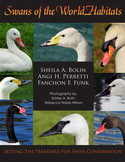Ask the Swan Specialist
Date: 5 September 2016
Hi Tracie:
It seems that you have done everything correctly by providing an introductory pen and slowly making a formal introduction. However, there are two major concerns we have.
One, the age of the cygnet is of major concern. We would not suggest taking a four month old cygnet from its parents. This is way too young in our opinion. We would only take a cygnet from the parents at this age if there was something physically wrong with the cygnet and it required medical or rehabilitative attention. The best time to remove a cygnet is when they are 6-8 months of age and the parents are telling the young juvenile to get lost prior to the next mating season.
This young swan has no means to protect itself, may not even know how to protect itself and could be severely injured for killed during the chases or beatings. This constant chasing can cause stress which can lead to injury, illness, dehydration and if the cygnet runs into another area to escape the larger swans, it could be susceptible to predation (wild-raccoons, coyotes, foxes, etc.) or (domestic-cats, dogs, humans, etc.). Bottom line, this cygnet is too young to be introduced into this type of setting.
Second, are you absolutely sure that you have a female swan? Most reputable swan keepers/sellers will provide you with the age of a cygnet/ medical records/ gender testing/and if they will take the swan back (time frame and illness/death clause). If a seller is so quick to provide you with a four month old swan, they may not be as careful to provide you with qualified gender information. Probing is a technique that some swan keepers will use, however, until the cygnet is approximately one year of age, this might not be a surety. Male genitalia may not fully develop until approximately one year of age, so if they are probing, what you might have at four months of age, may not be what you have in reality as the swan ages. The only guaranteed method of insuring gender is DNA sequencing in which a licensed veterinarian takes a DNA/feather sample and submits it to a reputable licensed DNA laboratory. Only this method will reliably provide you with the exact gender of the young swan.
So, now you have an issue of what you are going to do with the cygnet. First, you must determine if the cygnet is actually a female. If not, you are not going to be able to release the bird into this setting, and if it is a male, this might be the reason that the current problems are occurring.
If it is a male, you will need to find a safe habitat (new home) for the cygnet, preferably housed with young ducks, geese and swans in which it can learn how to be a swan. At four months of age, the parents may not have completed this education. The seller may or may not take the cygnet back, but it cannot be placed back with its family as the time spent at your house totally mitigates this option. The parents will see it as an intruder and the chasing/beatings will occur just as it is in your setting.
If it is a female, then you have two options, keep it in a pen setting until it gets larger and can protect itself (although unless the pen is relatively large, this may not be a humane adequate option for two-three more months). The other problem is that an older male could seriously injure her trying to mate with her during the upcoming mating season. She needs to be approximately 1 ˝ -2 years of age before mating. So, the time in the pen may need to be extended until after the upcoming mating season which again, poses a problem of keeping her in an enclosed setting for too long and not being able to freely swim and explore the habitat.
The only other option is to again, find her a safe new home and try to find an older female for the extra male swan. You will still need to introduce the older female in the same manner as you have with the cygnet using the introductory pen.
On another note, during mating season, the alpha male will again be chasing the other male and even if you get a mate for the extra male, there is no guarantee that the four will get along. In fact, depending on your pond size, this behavior may result in both extra swans being seriously hurt or dispatched from the pond resulting in injury, predation or illness.
We hope this information is of benefit. Please let us know how this situation progresses. The Regal Swan
Messages In This Thread
- Territorial Swan -- Tracie -- 5 September 2016
- Re: Territorial Swan -- The Regal Swan -- 5 September 2016
- Re: Territorial Swan -- Tracie -- 6 September 2016
- Re: Territorial Swan -- The Regal Swan -- 6 September 2016
- Re: Territorial Swan -- Tracie -- 6 September 2016
- Re: Territorial Swan -- The Regal Swan -- 5 September 2016
Ask the Swan Specialist is powered by
Tetra-WebBBS 5.30 Beta © 2006-2007 Tetra-Team






